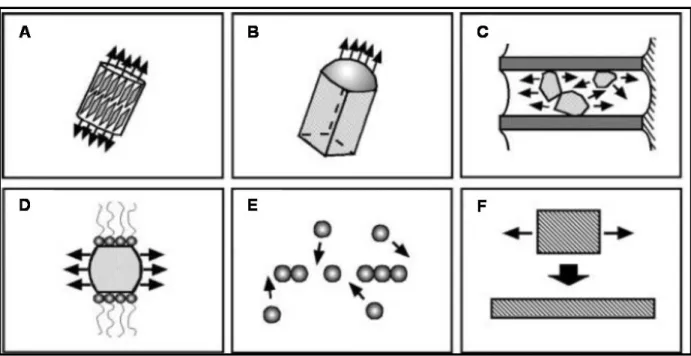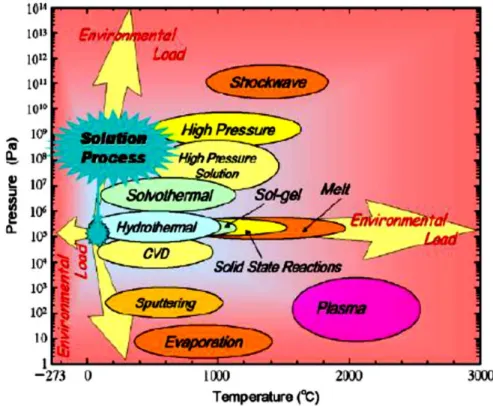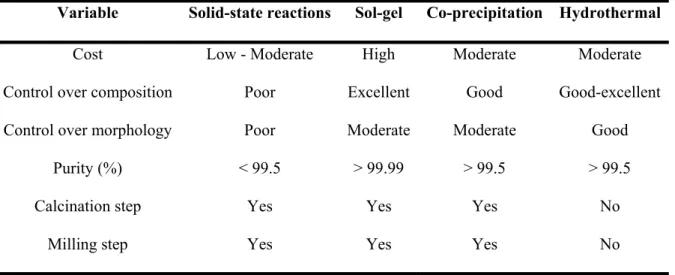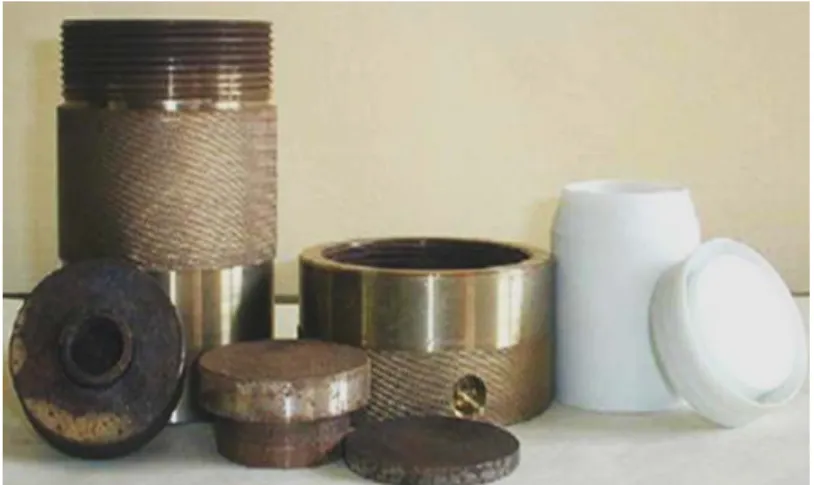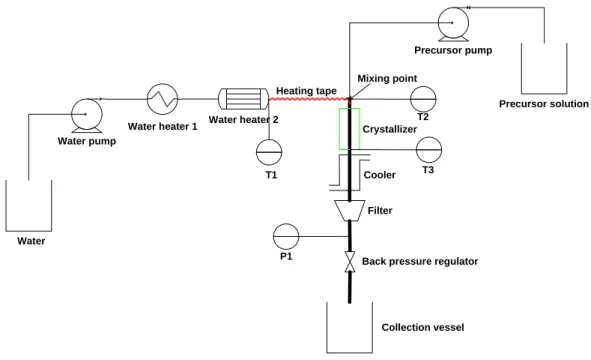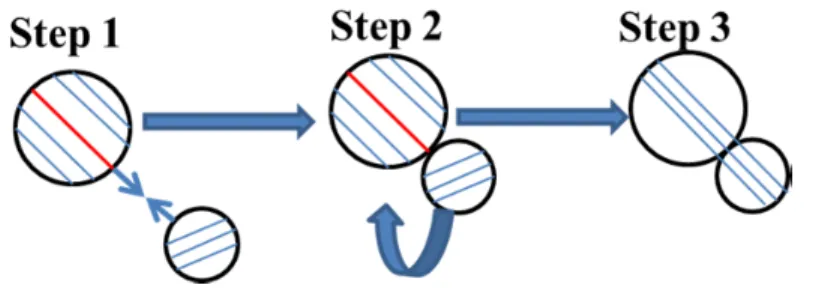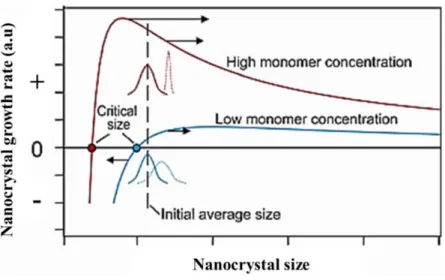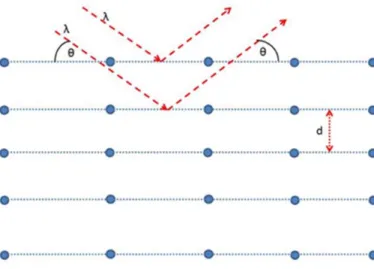The effect of organic solvents on the growth kinetics of β-FeOOH nanorods has been evaluated for the first time in this study. The effect of alcohol type on the particle morphology was found to be more pronounced at higher FeCl3.
TERMS AND CONCEPT
LIST OF ABBREVIATIONS
LIST OF SYMBOLS
GREEK SYMBOLS
Background
These physical properties are subject to the method used to produce these particles (Kandori et al., 2002). Liang et al., (2010) developed a continuous hydrothermal method to produce single crystal iron oxide nanoparticles using ferric nitrate and isopropanol (IPA).
Objectives of the study
Delineation of the study
Introduction
Iron oxides
- Structure of iron oxides
- Hematite α – Fe 2 O 3
- Akaganeite – β-FeOOH
- Applications of α-Fe 2 O 3 and β-FeOOH
- Particle formation mechanisms and applications of 1-D nanostructures
7 Figure 2.1 Different phases of iron oxides and hydroxides formed as a function of hydroxylation ratio and composition (Jolivet et al., 2006). Hematite (α-Fe2O3) has also been used as a photocatalyst for the degradation of chlorophenol and azo dyes (Bandara et al., 2007).
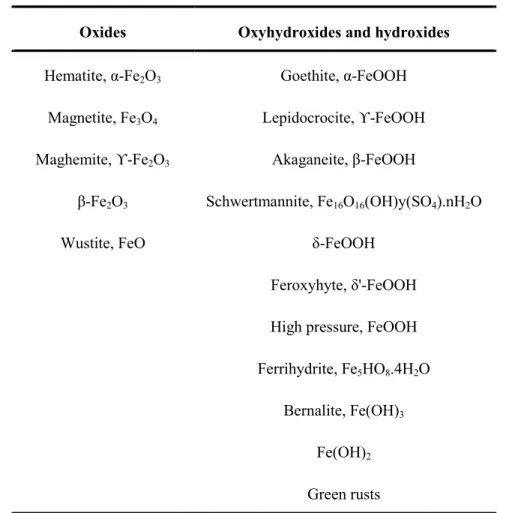
Fabrication approaches and techniques
- Batch synthesis
- Continuous synthesis
There are two techniques to produce nanoparticles (Figure 2.5), top-down and bottom-up approaches (Zheng, 2009). Hydrothermal synthesis (HS) of inorganic materials has been performed since the end of the 19th century (Byrappa & Yoshimura, 2001) and is defined as the precipitation of these materials from aqueous solutions at temperatures above the boiling point and at pressures greater than ambient . pressure (Dawson & Han, 1993).
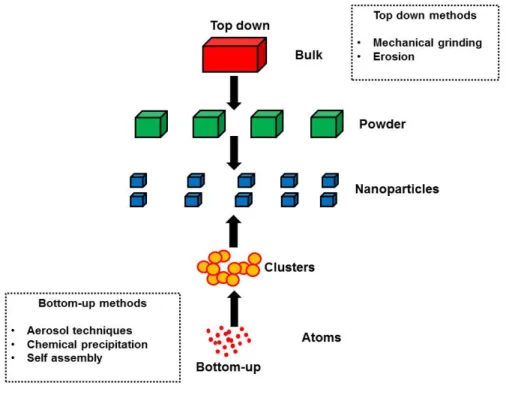
Effect of nanoparticle size on physical properties
The magnetization of a single-domain nanoparticle occurs along a simple direction determined by the shape and magnetocrystalline anisotropy of the nanoparticle. When an external field is applied in the opposite direction, the nanorod cannot respond with domain wall motion and instead the magnetization must reverse through the hard direction (Figure 2.9b) to the new easy direction (Figure 2.9c).
Prediction of nanoparticle sizes under different experimental conditions
Surfactants
- Previous work reported on the effect of surfactants and alcohols on the iron oxide nanoparticle
It has been reported that the length of the nanorods increases with the increase of carbon chain in the alcohol solvent. In another work, Guo and Xiao (2006) reported that the addition of alcohol in the hydrothermal reaction greatly affected the crystallization process.
An overview on the effect of processing conditions on β-FeOOH particle characteristics reported in literature in the absence of alcohol
- Effect of temperature on the β-FeOOH particle characteristics
- Effect of FeCl 3 concentrations on the β-FeOOH particle characteristics
The above discussion clearly emphasizes the application of various alcohols in the synthesis of various iron oxide nanoparticles. To my knowledge, no systematic study has been reported in the literature, despite the amount of work that has been done.
General synthesis theory
- Nucleation
- Growth mechanisms
- Classical growth kinetics, OR kinetics
- Oriented attachment, OA, mechanism
- OA based nanocrystal growth kinetic models .1 (A 1 +A 1 ) model
- Two-step reaction during the OA growth
- X-ray diffractometry
- Transmission electron microscopy (TEM)
- Scanning electron microscopy (SEM)
- Thermogravimetric analysis
- Energy dispersive spectroscopy
The first kinetic oriented growth model was developed to fit and explain the experimental growth curve of the ZnS nanoparticles (Huang et al., 2003). The first is the diffusion of the nanocrystals followed by coalescence and desorption of surface species.

Conclusion
A DTA curve provides information about the transformation that has occurred, such as glass transition, crystallization, melting, decomposition or sublimation, etc. The X-ray energy arising from the energy difference between the shells is characteristic of the atomic number. , and therefore can be used to ascertain the elemental composition of a sample (Almeida, 2010).
Introduction
General synthesis scheme of β-FeOOH particles
Different alcohols were used to evaluate the effect of carbon chain length and solvent surface tension on particle morphology and characteristics. The final pH of the resulting solution was ~2 under the experimental conditions used, unless otherwise stated. In general, the reaction took place for 2 hours, but other periods were also used to study their effect on the particle characteristics.
The duration of the synthesis was calculated from the time when the specified reaction temperature was reached, although particle formation would also have occurred during the temperature increase. The pressure fluctuation was observed due to the switching on and off of the heating elements. In addition, sulfate and nitrate precursors were also used to study the effect of anions on particle characteristics.
The reaction vessel was allowed to cool naturally after completion of the reaction, followed by decantation of the supernatant liquid, centrifugation, repeated washing of the solid with ethanol to remove residual chloride ions, and storage in a desiccator. A two-stage, three-factor experimental design was used to statistically identify the level of interactions between process parameters. Synthesis temperature and solution pH were omitted from the experimental design due to the sensitive dependence of the particle phase on these two variables.
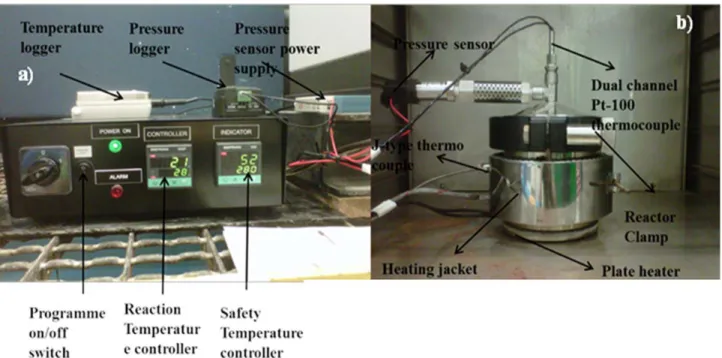
Chapter 4
- Introduction
- Experimental methodology
- Results and discussion
- Effect of BuOH-to-H 2 O and PrOH – to-H 2 O ratio on the akaganeite nanoparticle characteristics
- Relationship between particle size and surface tension
- Effect of pH on the growth of β-FeOOH nanoparticles
- Effect of alcohol on the Raman spectra of the synthesised particles
- Conclusion
- Introduction
- Experimental methodology
- Evaluation of growth mechanism via HRTEM
- Relationship between particle size and carbon number present in the linear alkyl chain of the solvent
- Relationship between solvent surface tension and growth rate constants
45 Figure 4.1 Dependence of morphological evolution as a function of variation on BuOH / H2O and PrOH / H2O ratio: (a) somatoids at 0% alcohol, (b) nanorods at 30% alcohol, (c) α-Fe2O3 spheres at 100 % alcohol, (d) aggregation of spherical particles at 100% alcohol, (e) β-FeOOH nanofibers at 98% alcohol and, f) XRD patterns of the synthesized particles at different solvent ratios. The results are summarized in Table 4.3. 48 Figure 4.2 % Reduction in particle size using solvent compared to without solvent; a) particle diameter. The morphologies developed as a function of alcohol-to-water ratio are illustrated in Figure 4.3. Somatoid particles were formed in mixture containing 10 vol % MeOH or EtOH in water.
With an increase in pH to 2.5, aggregation of the β-FeOOH rods (Figure 4.5 b) was observed in both butanol and propanol. Clustered α-Fe2O3 nanoparticles (Figure 4.5 d) were obtained at pH ~2.5 in ethanol as opposed to butanol and propanol. 60 Figure 4.7 Raman spectra of the sample prepared in the presence of alcohol: akaganeite (region 1), akaganeite + hematite (region 2) and hematite (region 3).
Side-by-side crystallographically oriented growth of akaganeite nanorods is shown in Figure 5.2 d, and a schematic overview is presented in Figure 5.2 e. Effect of methanol on the progressive growth β-FeOOH nanoparticles is illustrated in Figure 5.6.. 72 Figure 5.6 Structural evolution of particles as a function of time in methanol. 74 Figure 5.7 The relationship between particle size and carbon number present in the linear alkyl chain of the solvent 5.3.3 Growth kinetic evaluation of akaganite nanorods.
The typical pressure profile and diagrams of the thermodynamic behavior of the methanol-water system in the reactor are shown in Figures 5.14 and 5.15, respectively. The relationship between solvent surface tension and growth rate constants is exponential and independent of growth direction, as shown in Figure 5.16, which confirms the initial hypothesis.
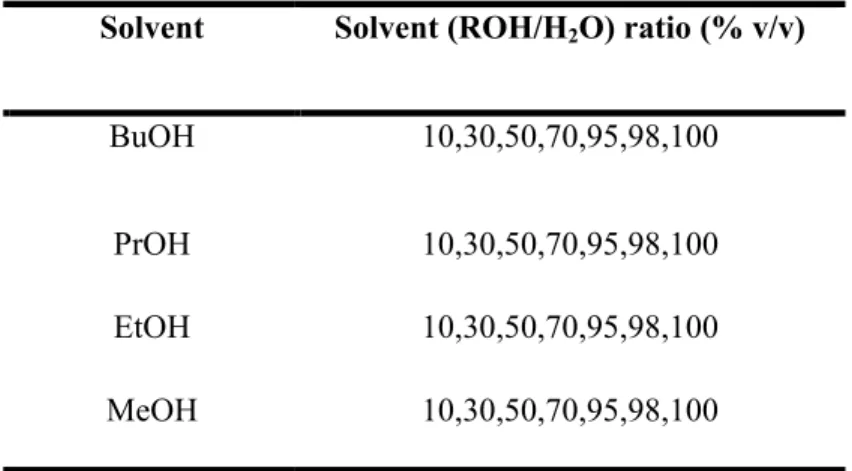
Chapter 6
- Introduction
- Experimental methodology
- Effect of FeCl 3 concentration .1 Structural evolution of particles
Pure crystalline β-FeOOH particles were synthesized regardless of the nature of the solvent used over FeCl3. Changing the concentrations of FeCl3 in BuOH significantly affects the morphology of akaganeite particles, as shown in Figure 6.2. 92 Figure 6.2 Dependence of morphological evolution as a function of FeCl3 concentration: a) nanorods in 0.1 M, b) cross-shaped + spindle-shaped in 0.5 M C) enlarged image of the cross structure, d) cleavage in 0.7 M, e) enlarged Fig. branched crystal and f) cleavage scheme.
Well-aligned rod-shaped β-FeOOH particles with smooth edges were obtained in a concentration range of 0.05–0.2 M (Figure 6.2a). The connection of the axis "A" and "B" (Figure 6.2 C) occurs through self-assembly, and the edges of the cross-structures were thick, reflecting the possibility of particles to grow in one-dimensional orientation. 2008) reported the synthesis of β-FeOOH cross-linked structures using urea under a synthesis temperature of 95°C and time of 8h. Branched β-FeOOH (Figure 6.2 e) obtained at 0.7M contradicts the observation at 0.5M. A number of single filamentary crystals were separated from a solid rod as can be seen from Figure 6.2 p. 2003) exploited the polyptism between hexagonal and cubic structures to create branching points in the semiconductor nanocrystal.
Cleaved β-FeOOH can find applications where a larger surface area is needed because each filament has a different surface area. It is then thermodynamically favorable for a large crystal to cleave, because of the strong adhesion of the surfactant to the newly created surface. It can thus be postulated that the morphological evolution was merely due to the presence of butanol.
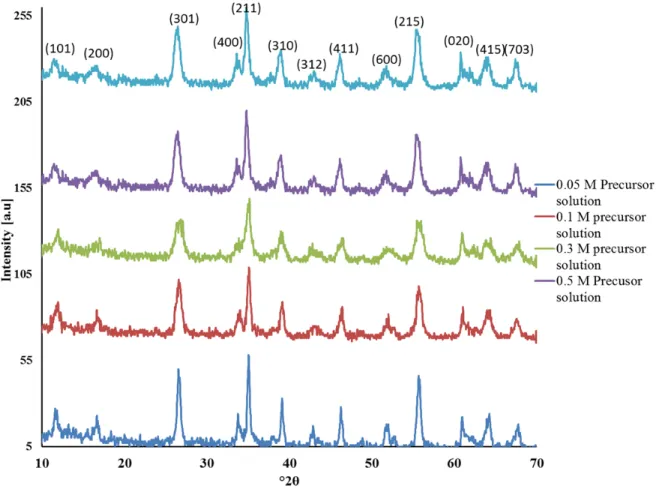
Conc
- Morphological evolution of β-FeOOH particles in EtoH and MeOH
- Effect of anions on the particle characteristics
- Effect of reaction temperature on the particle characteristics .1 Transformation of β-FeOOH to α-Fe 2 O 3 in BuOH and PrOH
- Conclusion
- Introduction
- Summary
- Conclusion
- Significant contribution
- Future research contribution
The d-spacing and the SAED patterns of the nanorods and pseudocubes observed at 135 °C are shown in Figure 6.7d, which agrees well with the standard akaganeite and α-Fe2O3 patterns. Quantification of the two phases (Figure 6.9) shows that 60% of the peaks in the XRD pattern represent α-Fe2O3 and the remainder β-FeOOH. The % mass loss, as shown in Figure 6.12b, is linearly dependent on the number of carbon atoms present in the linear alkyl chain of the solvent.
111 Figure 6.12 a) Thermogravimetric analysis of the synthesized nanorods and b) correlation between % mass loss and number of carbons in the linear alkyl chain of the solvents. Evaluation of the impact of main factors revealed that these parameters have positive effects on the image formats. 114 A generalized correlation is proposed based on the importance of effects of the parameters and the relationship between solvent surface tension and particle characteristics on the particle growth.
The effect of solvents on the growth kinetics of β-FeOOH nanorods was evaluated in Chapter 5. The shape of the particle size distribution was related to the growth mechanism of the nanorods. This study relates the role of solvent surface tension to particle growth, which is original.
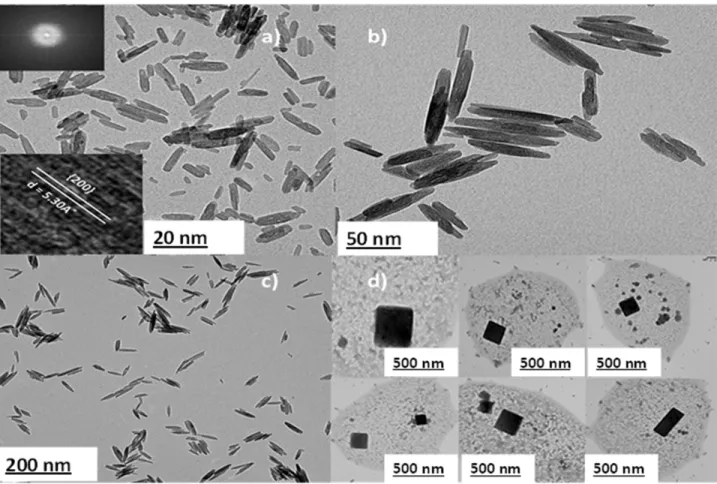
Development and application of iron oxide nanoparticles (Part 1): Synthesis of iron oxide nanoparticles for MRI.
Appendices
Appendix A
Main reference: Post, J., National Museum of Natural History, Smithsonian Institution, Washington, DC, USA, ICDD Grant-in-Aid, (1989). Model revised by Syvinski, W., McCarthy, G., North Dakota State Univ., Fargo, North Dakota, USA, ICDD Grant-in-Aid (1990).
Appendix B
I am writing to you regarding the measurement of surface tension at high temperature and pressure. I have read an article by SINTEF on measuring surface tension (I have attached a pdf). My research area is materials science. I have submitted a paper to the Journal of crystal growth that evaluates the functional relationship between solvent surface tension and particle growth rate.
However, the editor will only accept the paper if I show the surface tension of the solvents under hydrothermal conditions (at 100 degrees c and 200-300 kPa). I would like to know if you can help me in measuring the surface tension of 4 different alcohols, (pure alcohol: 1. methanol, 2. ethanol, 3. propanol and 4. butanol: and also 50:50 mixture of of the same alcohol + water) at this specific temperature and pressure. You can charge me the cost of running the experiments or you can co-author the paper as it will be accepted after the data is provided and the paper is reviewed.
So you can decide how you want to do it, either co-author or charge me for your service. However, the editor will accept the paper only if I show the surface tensions of the solvents under hydrothermal conditions (at 100
